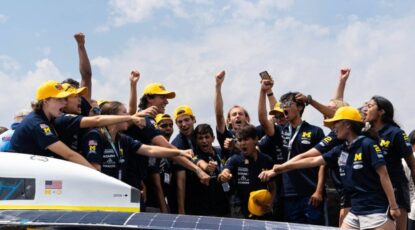Innovation
-
Green hydrogen: Powering the future of passenger and freight transportation?
Green hydrogen is emerging as an important potential solution for decarbonizing transportation, but new energy efficiency findings indicate that it should be used strategically in heavy-duty road, rail, aviation, and marine transportation, a U-M study shows.
-
National champs: U-Michigan Solar Car Team takes first in American Solar Challenge
The team covered 2,120 miles before reclaiming U-M’s title as national champions. Michigan students had won six consecutive American Solar Challenges, held every other year, until finishing second in 2018. This is the first U.S. race they’ve competed in since then, due to the COVID-19 pandemic.
-
When will cars drive themselves?
As you think about your next vehicle purchase, you may be considering GM’s Super Cruise or Ford’s BlueCruise. Perhaps you’ve got your eye on a Tesla. Before you head to the dealer, listen as Henry Liu, director of Mcity and the Center for Connected and Automated Transportation, explains your autonomous options.
-
Using AI to decode dog vocalizations
U-M researchers are exploring the possibilities of AI, developing tools that can identify whether a dog’s bark conveys playfulness or aggression. The same models can also glean other information from animal vocalizations, such as the animal’s age, breed, and sex.
-
U-M part of consortium to design, construct powerful new instrument to unlock universe’s secrets
U-M’s Dept. of Astronomy is collaborating on ANDES, a powerful instrument designed to reveal the nature of atmospheres of planets around nearby stars, rare elements forged in the interiors of stars, the formation of galaxies, and even the evolution of the universe itself.
-
U-M-led school for oceanographers in Africa receives funding from Schmidt Sciences
The Coastal Ocean Environment Summer School in Nigeria and Ghana was founded by Brian Arbic, a physical oceanographer and U-M professor in earth and environmental sciences. Google CEO Eric Schmidt and Wendy Schmidt are founders of Schmidt Sciences.
-
Nanoscale engineering brings light-twisting materials to more extreme settings
Imaging the hot turbulence of aircraft propulsion systems may now be possible with sturdy sheets of composite materials that twist light beams, according to new research led by U-M and the Air Force Research Laboratory.
-
AI chips could get a sense of time
Timekeeping in the brain is done with neurons that relax at different rates after receiving a signal; now memristors—hardware analogues of neurons—can do that too. Artificial neural networks may soon be able to process time-dependent information, such as audio and video data, more efficiently.
-
Managing screen time by making phones slightly more annoying to use
The best way to help smartphone users manage their screen time may be to make phones progressively more annoying to use, according to new U-M research. Delaying a phone’s swiping and tapping functions forces users to think harder, making it easier for them to consider whether to keep scrolling.










